Hi
- In unicellular organisms, all functions like digestion, respiration and reproduction are performed by a single cell.
- Simple organism like Hydra is made of different types of cells and the number of cells in each type can be in thousands.
- In multicellular animals, a group of similar cells alongwith intercellular substances perform a specific function. Such an organisation is called tissue.
- Tissues are organised in specific proportion and pattern to form an organ like stomach, lung, heart and kidney.
- When two or more organs perform a common function by their physical and/or chemical interaction, they together form organ system, e.g., digestive system, respiratory system, etc. ▪Animal Tissues
- Tissues are different and are broadly classified into four types :
1. Epithelial 2. Connective 3. Muscular 4. Neural
1. Epithelial Tissue
Tissue has a free surface, which faces either a body fluid or the outside environment and thus provides a covering or a lining for some part of the body.
Cells are compactly packed with little intercellular matrix.
•Two types of epithelial tissues :- (i) Simple epithelium (ii) Compound epithelium
- Simple epithelium - composed of a single layer of cells and functions as a lining for body cavities, ducts, and tubes.
- Compound epithelium - consists of two or more cell layers and has protective function as it does in our skin
(i) Basis of structural modification of the cells, simple epithelium is divided into three types.
(a) Squamous (b) Cuboidal (c) Columnar
(a)Squamous epithelium - made of a single thin layer of flattened cells with irregular boundaries.
-Found in the walls of blood vessels and air sacs of lungs and are involved in functions like forming a diffusion boundary. (NEET 2010,2011)
(b)Cuboidal epithelium - composed of a single layer of cube-like cells.
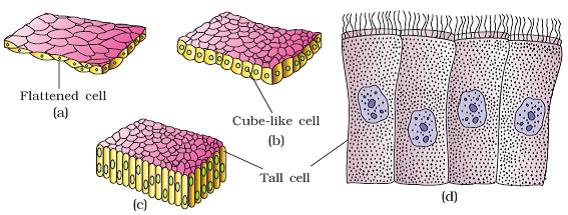
- Found in ducts of glands and tubular parts of nephrons in kidneys and its main functions are secretion and absorption.
- Epithelium of proximal convoluted tubule (PCT) of nephron in the kidney has microvilli.
(c)Columnar epithelium - composed of a single layer of tall and slender cells and their nuclei are located at the base. (Diagram in NEET 2012)
- Free surface may have microvilli.
- Found in the lining of stomach and intestine and help in secretion and absorption.
•Ciliated Epithelium - Columnar or cuboidal cells bear cilia on their free surface they are called ciliated epithelium.
- Function is to move particles or mucus in a specific direction over the epithelium.
- Present in the inner surface of hollow organs like bronchioles and fallopian tubes. (NEET 2009,2011)
- Glandular Epithelium - Some of the columnar or cuboidal cells get specialised for secretion and are called glandular epithelium. (NEET 2014)
- Mainly of two types: (Diagram 7.2 unicellular in NEET 2012)
i.Unicellular - consisting of isolated glandular cells (goblet cells of the alimentary canal).
ii.Multicellular - consisting of cluster of cells (salivary gland).
Basis of the mode of pouring of their secretions, glands are divided into two
a.Exocrine glands - secrete mucus, saliva, earwax, oil, milk, digestive enzymes and other cell products.
-These products are released through ducts or tubes.
b.Endocrine glands - Products called hormones are secreted directly into the fluid bathing the gland.
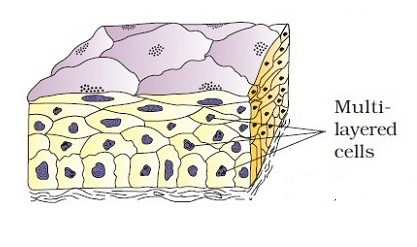
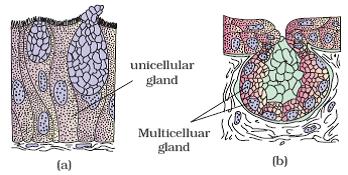
-Endocrine glands do not have ducts.
(ii) Compound epithelium - made of more than one layer
(multi-layered) of cells and thus has a limited role in secretion and absorption.
- Main function is to provide protection against chemical and mechanical stresses.
- Cover the dry surface of the skin, the moist surface of buccal cavity, pharynx, inner lining of ducts of salivary glands and of pancreatic ducts.
▪All cells in epithelium are held together with little intercellular material.
- All animal tissues, specialised junctions provide both structural and functional links between its individual cells.
•Three types of cell junctions are found in the epithelium and other tissues. (Aipmt 2009)
(a) Tight (b) Adhering (c) Gap junctions.
- Tight junctions - help to stop substances from leaking across a tissue.
- Adhering junctions - perform cementing to keep neighbouring cells together.
- Gap junctions - facilitate the cells to communicate with each other by connecting the cytoplasm of adjoining cells, for rapid transfer of ions, small molecules and sometimes big molecules. (NEET 2015)
2. Connective Tissue
- Most abundant and widely distributed in the body of complex animals.
- Named connective tissues because of their special function of linking and supporting other tissues/organs of the body.
- Range from soft connective tissues to specialised types, which include cartilage, bone, adipose, and blood.
- All connective tissues except blood, the cells secrete fibres of structural proteins called collagen or elastin.
- Fibres provide strength, elasticity and flexibility to the tissue.
- These cells also secrete modified polysaccharides, which accumulate between cells and fibres and act as matrix (ground substance).
Connective tissues are classified into three types:
- Loose connective tissue
- Dense connective tissue
- Specialised connective tissue.

(i) Loose Connective tissue
-Cells and fibres loosely arranged in a semi-fluid ground substance.
•It is of two types :- a. Areolar tissue b. Adipose tissue
a.Areolar tissue - present beneath the skin.
-It serves as a support framework for epithelium and contains fibroblasts (cells that produce and secrete fibres), macrophages and mast cells. (NEET 2014,2016 & Fig. In NEET 2012)
b.Adipose tissue - Located mainly beneath the skin and cells of this tissue are specialised to store fats.
-Excess of nutrients which are not used immediately are converted into fats and are stored in this tissue.
(ii)Dense Connective tissue - Fibres and fibroblasts are compactly packed.
It is of two types - a. Dense Regular b. Dense Irregular
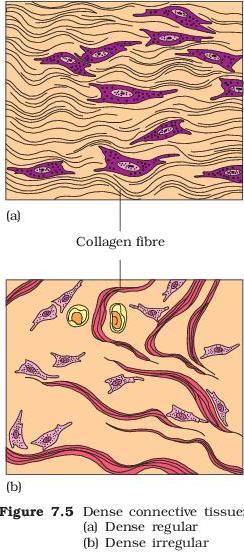
1.Dense Regular - the collagen fibres are present in rows between many parallel bundles of fibres. (Diagram in NEET 2012)
It is also of two types :- ☆ Tendon ☆ Ligament
☆ Tendons, which attach skeletal muscles to bones (NEET 2011)
☆ ligaments which attach one bone to another bone
2.Dense irregular connective tissue - has fibroblasts and many fibres (mostly collagen) that are oriented differently. This tissue is present in the skin.
(iii)Special Connective tissue - Cartilage, bones and blood.

•Cartilage - The intercellular material of cartilage is solid and pliable and resists compression.
- Cells of this tissue (chondrocytes) are enclosed in small cavities within the matrix secreted by them.
- Most of the cartilages in vertebrate embryos are replaced by bones in adults.
- Cartilage is present in the tip of nose, outer ear joints, between adjacent bones of the vertebral column, limbs and hands in adults. (NEET 2009,2012,2014)
Bones - A hard and non-pliable ground substance rich in calcium salts and collagen fibres which give bone its strength.
- Main tissue that provides structural frame to the body.
- Bones support and protect softer tissues and organs.
- The bone cells (osteocytes) are present in the spaces called lacunae.
- Limb bones, such as the long bones of the legs, serve weight- bearing functions.
- interact with skeletal muscles attached to them to bring about movements.
- Bone marrow in some bones is the site of production of blood cells.
Blood
is a fluid connective tissue containing plasma, red blood cells (RBC), white blood cells (WBC) and platelets.
Main circulating fluid that helps in the transport of various substances.
3. Muscle Tissue
- Each muscle is made of many long, cylindrical fibres arranged in parallel arrays composed of numerous fine fibrils, called myofibrils.
- Muscle fibres contract (shorten) in response to stimulation, then relax (lengthen) and return to their uncontracted state in a coordinated fashion.
- Muscles play an active role in all the movements of the body.
•Muscles are of three types
(i) Skeletal (ii) Smooth (iii) Cardiac.
(i)Skeletal muscle - tissue is closely attached to skeletal bones.
- Typical muscle such as the biceps, striated (striped) skeletal muscle fibres are bundled together in a parallel fashion.
- A sheath of tough connective tissue encloses several bundles of muscle fibres.
(ii)Smooth muscle - fibres taper at both ends (fusiform) and do not show striations. (NEET 2016) (Fig 7.7 in NEET 2012,2013)
- Cell junctions hold them together and they are bundled together in a connective tissue sheath.
- Wall of internal organs such as the blood vessels, stomach and intestine contains this type of muscle tissue.
- Smooth muscles are ‘involuntary’ as their functioning cannot be directly controlled.
(iii)Cardiac muscle - tissue is a contractile tissue present only in the heart.
- Cell junctions fuse the plasma membranes of cardiac muscle cells and make them stick together.
- Communication junctions (intercalated discs) at some fusion points allow the cells to contract as a unit, i.e., when one cell receives a signal to contract, its neighbours are also stimulated to contract.
4. Neural Tissue
- Neural tissue exerts the greatest control over the body’s responsiveness to changing conditions.
- Neurons, the unit of neural system are excitable cells.
- Neuroglial cell which constitute the rest of the neural system protect and support neurons.
- Neuroglia make up more than onehalf the volume of neural tissue in our body
Cockroach
- Cockroaches are brown or black bodied animals that are included in class Insecta of Phylum Arthropoda.
- Bright yellow, red and green coloured cockroaches have also been reported in tropical regions.
- Their size ranges from ¼ inches to 3 inches (0.6-7.6 cm) and have long antenna, legs and flat extension of the upper body wall that conceals head.
- They are nocturnal omnivores that live in damp places throughout the world.
- Residents of human homes and thus are serious pests and vectors of several diseases.
Morphology
- Adults of the common species of cockroach, Periplaneta americana are about 34-53 mm long with wings that extend beyond the tip of the abdomen in males.
- The body of the cockroach is segmented and divisible into three distinct regions – head, thorax and abdomen.
- The entire body is covered by a hard chitinous exoskeleton (brown in colour).
- In each segment, exoskeleton has hardened plates called sclerites (tergites dorsally and sternites ventrally) that are joined to each other by a thin and flexible articular membrane
(arthrodial membrane). (NEET 2015)
- Head is triangular in shape and lies anteriorly at right angles to the longitudinal body axis formed by the fusion of six segments and shows great mobility in all directions due to flexible neck.
- Head capsule bears a pair of compound eyes.
- A pair of thread like antennae arise from membranous sockets lying in front of eyes.
- Antennae have sensory receptors that help in monitoring the environment.
- Anterior end of the head bears appendages forming biting and chewing type of mouth parts.
- The mouthparts consisting of a labrum (upper lip), a pair of mandibles, a pair of maxillae and a labium (lower lip).
- A median flexible lobe, acting as tongue (hypopharynx), lies within the cavity enclosed by the mouthparts.
- Thorax consists of three parts – prothorax, mesothorax and metathorax.
- The head is connected with thorax by a short extension of the prothorax known as the neck.
- Each thoracic segment bears a pair of walking legs.
- First pair of wings arises from mesothorax and the second pair from metathorax.
- Forewings (mesothoracic) called tegmina are opaque dark and leathery and cover the hind wings when at rest and hind wings are transparent, membranous and are used in flight.
- The abdomen in both males and females consists of 10 segments.
- In female, 7th sternum is boat shaped and together with the 8th and 9th sterna forms a brood or genital pouch whose anterior part contains female gonopore, spermathecal pores and collateral glands.
In males, genital pouch or chamber lies at the hind end of abdomen bounded dorsally by 9th and 10th terga and ventrally by the 9th sternum.
- It contains dorsal anus, ventral male genital pore and gonapophysis.
- Males bear a pair of short, threadlike anal styles/caudal style which are absent in females. (NEET 2012,2013,2018)
- In both sexes, the 10th bears a pair of jointed filamentous structures called anal cerci.
Anatomy
•Digestive system - (NEET 2019 Fig. 7.16)
Alimentary canal present in the body cavity is divided into three regions: foregut, midgut and hindgut.
- The mouth opens into a short tubular pharynx, leading to a narrow tubular passage called oesophagus and opens into a sac like structure called crop used for storing of food.
- Crop is followed by gizzard or proventriculus.
- Gizzard has an outer layer of thick circular muscles and thick inner cuticle forming six highly chitinous plate called teeth.
- Gizzard helps in grinding the food particles.
- Entire foregut is lined by cuticle.
- A ring of 6-8 blind tubules called hepatic or gastric caeca is present at the junction of foregut and midgut, which secrete digestive juice.
- At the junction of midgut and hindgut is present another ring of 100-150 yellow coloured thin filamentous Malpighian tubules.
- Malpighian tubules help in removal of excretory products from haemolymph.
- The hindgut is broader than midgut and is differentiated into ileum, colon and rectum and rectum opens out through anus.
•Blood Circulation System-
- Blood vascular system is an open type
- Blood vessels are poorly developed and open into space (haemocoel).
- Visceral organs located in the haemocoel are bathed in blood (haemolymph).
- Haemolymph is composed of colourless plasma and haemocytes.
- Heart of cockroach consists of elongated muscular tube lying along mid dorsal line of thorax and abdomen and differentiated into funnel shaped chambers with ostia on either side.
- Blood from sinuses enter heart through ostia and is pumped anteriorly to sinuses again.
•Respiratory system - consists of a network of trachea, that open through 10 pairs of small holes called spiracles present on the lateral side of the body.
- Thin branching tubes (tracheal tubes subdivided into tracheoles) carry oxygen from the air to all the parts.
- opening of the spiracles is regulated by the sphincters. Exchange of gases take place at the tracheoles by diffusion.
•Excretion System -
Performed by Malpighian tubules and each tubule is lined by glandular and ciliated cells.
- They absorb nitrogenous waste products and convert them into uric acid which is excreted out through the hindgut. ( insect is called uricotelic.) (NEET 2015)
- The fat body, nephrocytes and urecose glands also help in excretion.
•Nervous system - Consists of a series of fused, segmentally arranged ganglia joined by paired longitudinal connectives on the ventral side.
- Three ganglia lie in the thorax, and six in the abdomen and spread throughout the body.
- head holds a bit of a nervous system while the rest is situated along the ventral (belly-side) part of its body if the head of a cockroach is cut off, it will still live for as long as one week.
- Brain is represented by supra-oesophageal ganglion which supplies nerves to antennae and compound eyes.
- Sense organs are antennae, eyes, maxillary palps, labial palps, anal cerci, etc.
- Compound eyes are situated at the dorsal surface of the head and each eye consists of about 2000 hexagonal ommatidia (sing.: ommatidium).
- With the help of several ommatidia, a cockroach can receive several images of an object. This kind of vision is known as mosaic vision with more sensitivity but less resolution, being common during night (hence called nocturnal vision).
•Reproductive System
- Cockroaches are dioecious and both sexes have well developed reproductive organs.
- Male reproductive system consists of a pair of testes one lying on each lateral side in the 4th-6th abdominal segments.
- From each testis arises a thin vas deferens, which opens into ejaculatory duct through seminal vesicle.
- The ejaculatory duct opens into male gonopore situated ventral to anus.
- A characteristic mushroom shaped gland is present in the 6th-7th abdominal segments which functions as an accessory reproductive gland.
- The external genitalia are represented by male gonapophysis or phallomere (chitinous asymmetrical structures, surrounding the male gonopore).
- The sperms are stored in the seminal vesicles and are glued together in the form of bundles called spermatophores which are discharged during copulation. (NEET 2016)
- Female reproductive sysytem - consists of two large ovaries, lying laterally in the 2nd-6th abdominal segments.
- Each ovary is formed of a group of eight ovarian tubules or ovarioles, containing a chain of developing ova.
- Oviducts of each ovary unite into a single median oviduct (also called vagina) which opens into the genital chamber.
- A pair of spermatheca is present in the 6th segment which opens into the genital chamber.
- Sperms are transferred through spermatophores. Their fertilised eggs are encased in capsules called oothecae.
- Ootheca is a dark reddish to blackish brown capsule, about 3/8" (8 mm) long and dropped or glued to a suitable surface, usually in a crack or crevice of high relative humidity near a food source.
- females produce 9-10 oothecae, each containing 14-16 eggs and development of P. americana is paurometabolous, meaning there is development through nymphal stage
- . The nymphs look very much like adults.
- The nymph grows by moulting about 13 times to reach the adult form. The next to last nymphal stage has wing pads but only adult cockroaches have wings. (NEET 2013)
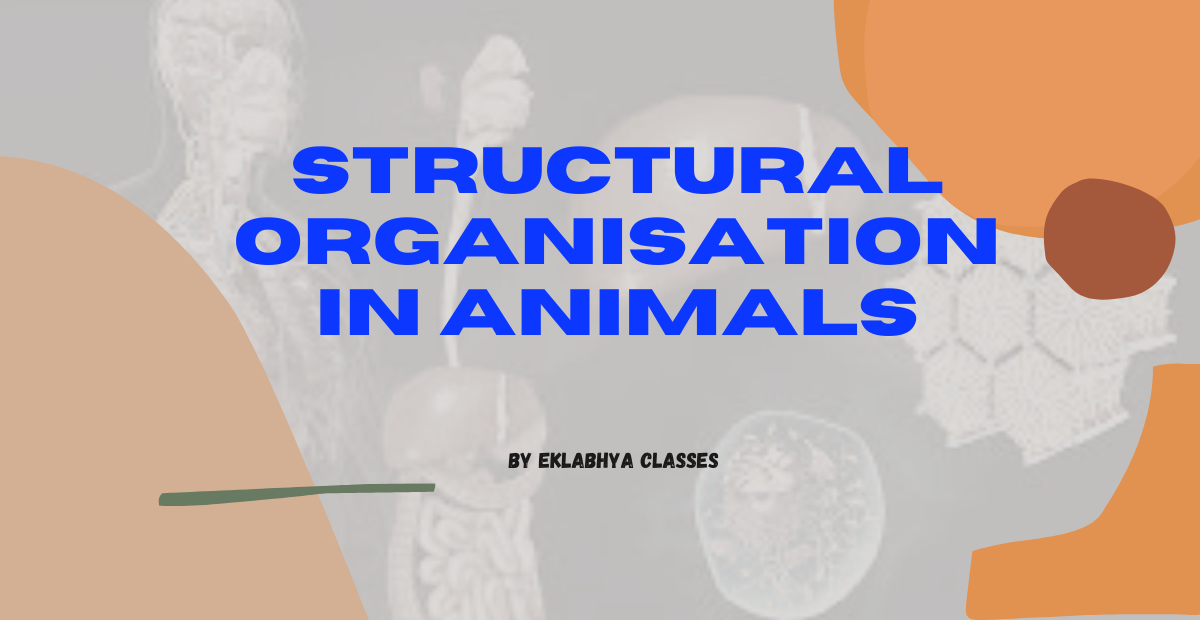

I most keep reading your blog, I admire your work for everyone <a href=”https://www.realundetectablepropmoney.com/product/new-style-20-full-print-prop-money-stack/”>canadian prop money</a>
<a href=”https://www.midwayprimers.com/”>209 primers midway</a> made me understand this for the first time and i love it
… [Trackback]
[…] Find More Information here on that Topic: eklabhyaclasses.com/blog/structural-organisation-in-animals-2/ […]
… [Trackback]
[…] Find More on on that Topic: eklabhyaclasses.com/blog/structural-organisation-in-animals-2/ […]
… [Trackback]
[…] Find More Info here to that Topic: eklabhyaclasses.com/blog/structural-organisation-in-animals-2/ […]
… [Trackback]
[…] Find More on to that Topic: eklabhyaclasses.com/blog/structural-organisation-in-animals-2/ […]
… [Trackback]
[…] Find More to that Topic: eklabhyaclasses.com/blog/structural-organisation-in-animals-2/ […]
… [Trackback]
[…] Read More here on that Topic: eklabhyaclasses.com/blog/structural-organisation-in-animals-2/ […]
… [Trackback]
[…] Find More to that Topic: eklabhyaclasses.com/blog/structural-organisation-in-animals-2/ […]
… [Trackback]
[…] Information on that Topic: eklabhyaclasses.com/blog/structural-organisation-in-animals-2/ […]
… [Trackback]
[…] Read More here on that Topic: eklabhyaclasses.com/blog/structural-organisation-in-animals-2/ […]
… [Trackback]
[…] Read More Info here to that Topic: eklabhyaclasses.com/blog/structural-organisation-in-animals-2/ […]
… [Trackback]
[…] Information on that Topic: eklabhyaclasses.com/blog/structural-organisation-in-animals-2/ […]
… [Trackback]
[…] Find More Info here to that Topic: eklabhyaclasses.com/blog/structural-organisation-in-animals-2/ […]
… [Trackback]
[…] Read More to that Topic: eklabhyaclasses.com/blog/structural-organisation-in-animals-2/ […]
… [Trackback]
[…] Find More on to that Topic: eklabhyaclasses.com/blog/structural-organisation-in-animals-2/ […]
… [Trackback]
[…] Read More to that Topic: eklabhyaclasses.com/blog/structural-organisation-in-animals-2/ […]
… [Trackback]
[…] Read More on that Topic: eklabhyaclasses.com/blog/structural-organisation-in-animals-2/ […]
… [Trackback]
[…] Read More on on that Topic: eklabhyaclasses.com/blog/structural-organisation-in-animals-2/ […]
… [Trackback]
[…] There you can find 29946 additional Information to that Topic: eklabhyaclasses.com/blog/structural-organisation-in-animals-2/ […]
… [Trackback]
[…] Find More to that Topic: eklabhyaclasses.com/blog/structural-organisation-in-animals-2/ […]
… [Trackback]
[…] Find More Info here to that Topic: eklabhyaclasses.com/blog/structural-organisation-in-animals-2/ […]
… [Trackback]
[…] Find More here on that Topic: eklabhyaclasses.com/blog/structural-organisation-in-animals-2/ […]
… [Trackback]
[…] Read More on that Topic: eklabhyaclasses.com/blog/structural-organisation-in-animals-2/ […]